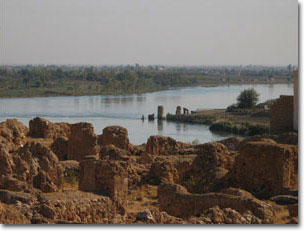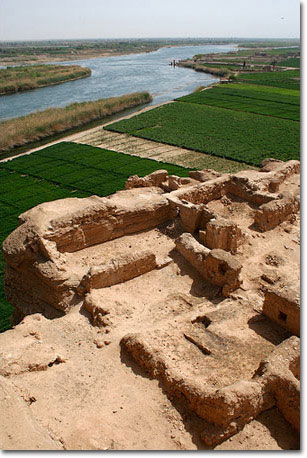|
Dura
Europos (Tell al-Salihiye):  It's on the right bank of the Euphrates about
90 km south east of Deir Ezzor (about 40 km
north west of Abu Kemal). When the first paintings
at Dura were uncovered by accident by a British
expeditionary force in April 1920, few could
have expected that the incident was about to
provide a new perspective on early Christian
and Judaic art. Dura's remains would not only
illustrate the part it played in the drawn out
struggle between cultural, political and military
influences between east and west but shed an
unexpected new light on early representational
art of the Christian and Jewish traditions. It's on the right bank of the Euphrates about
90 km south east of Deir Ezzor (about 40 km
north west of Abu Kemal). When the first paintings
at Dura were uncovered by accident by a British
expeditionary force in April 1920, few could
have expected that the incident was about to
provide a new perspective on early Christian
and Judaic art. Dura's remains would not only
illustrate the part it played in the drawn out
struggle between cultural, political and military
influences between east and west but shed an
unexpected new light on early representational
art of the Christian and Jewish traditions.
Dura Europos was established at the beginning
of the Hellenistic period when the empire of
Alexander was divided among his heirs and northern
Syria/Mesopotamia was apportioned to Seleucos
I Nicator. It was not established as a planned
city until the mid second century BC. Dura was
the focal point of a network of military colonies
implanted to secure Seleucid control of the
Mid Euphrates. Dura formed a defensive strongpoint
on the access route between the two major military
centers, Apamea and Seleucia on the Tigris.
The typical grid plan city was established and
the name chosen, Europos, referred to the birthplace
of Seleucos I Nicator in Macedonia. Even under
the Romans, the replacement of the mud-brick
upper courses of the walls with stone was not
fully realized and the Seleucid citadel was
left unfinished long before it was abandoned. 
After the Parthians pushed their frontier westwards
to the Euphrates in 141 BC, Seleucid control
was constricted. The town was dominated by Parthia
from 113 BC and the townspeople made the necessary
concessions to both sides to avoid a show-down
over the issue. Dura remained Parthian to the
end of the 1st century AD. A "live and let live"
policy along the Euphrates was recognized by
a treaty between Romans and Parthians signed
under Augustus in 20 BC. Trajan occupied the city in AD 115 as part of
his ill-advised attempt to take control of Parthia
and push the frontier across the Euphrates into
Mesopotamia. Trajan had left his nephew and
adopted heir, Hadrian, as Governor of Syria.
On succeeding his uncle, Hadrian reverted to
a softer policy on the frontier and gave Dura
back to the Parthians. Three years after an earthquake severely damaged
the city (161); Rome again took direct control
under Lucius Verus, stationing its own troops
there and for the first time incorporating Dura
into the province of Syria. It was declared
a Roman colony in 211. The Sassanians, after
227, took over the city and comforted themselves
with new constructions; the theater, the barracks
and the baths. The period of full Roman control saw a remarkable
flourishing of religious architecture in pagan,
Jewish and Christian styles, with some notable
similarities between the three. The town remained
dominated by its Greek cultural origins and
the language of civic life, as in most of Syria,
was Greek. The Roman military camp preserved
its separate identity based on its imperial
connections. Shapur I decided to destroy the town and banish
its people rather than make it a Sassanian fortress.
Then the Euphrates was left for centuries without
strong points to stabilize the shifting frontier
between east and west. The Gates:  - The Triumphal Gate - The Triumphal Gate
built in honor of the III Cyrenaica legion during Trajan's brief imposition of Roman direct rule (115 - 7). - The Great Gate also named "Palmyra Gate" on the west side. It comprised two bastions
each with two guard rooms, the top rooms being linked by a passageway
over the inner archway. It dates from the 2nd century BC. The Temples: The colonnaded street leads to three Roman bath sites, the Christian
chapel (232 AD), the temple of Zeus Kyriosand, temple of Gadde (Baal
family), Temple of Zeus Theos (AD 114) and temple of Zeus Megistos (AD
169). Temple of Artemis: Dates from the Parthian rebuilding in 40 - 33 BC. This served as the
center of the city's principal official cult throughout the Greek,
Parthian and Roman times. Temple of Atargatis: East of Artemis Temple is this 31 - 2 AD temple that was built in honor of the Syrian goddess Atragatis. |


